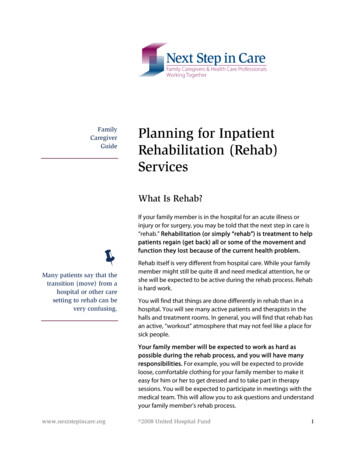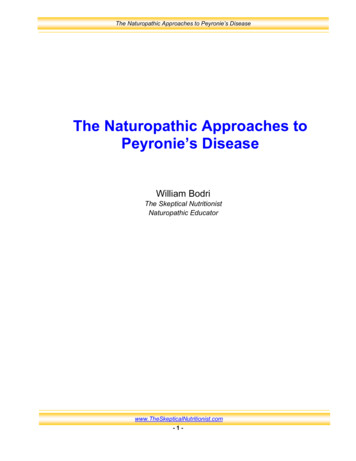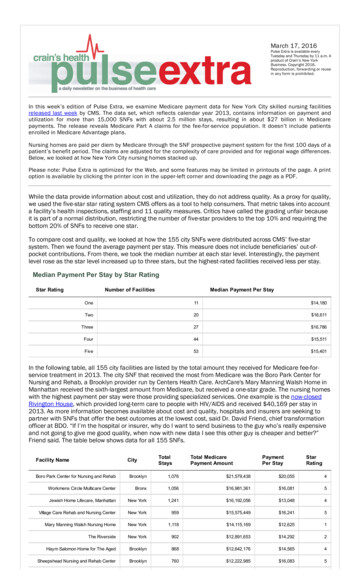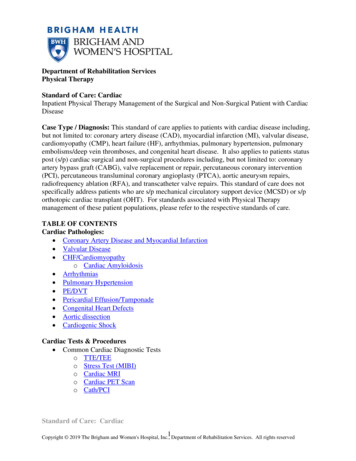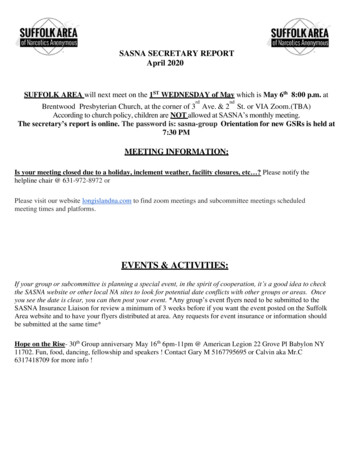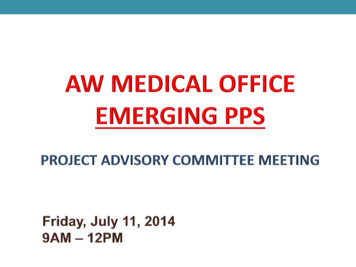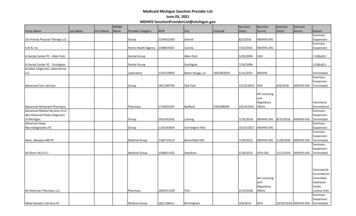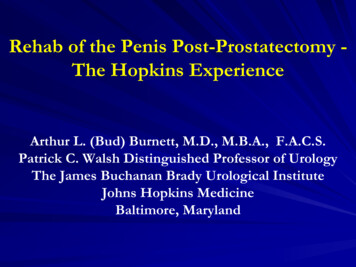
Transcription
Rehab of the Penis Post-Prostatectomy The Hopkins ExperienceArthur L. (Bud) Burnett, M.D., M.B.A., F.A.C.S.Patrick C. Walsh Distinguished Professor of UrologyThe James Buchanan Brady Urological InstituteJohns Hopkins MedicineBaltimore, Maryland
Disclosure Statement: In accordance withACGME policy on relevant financialdisclosure, I disclose financial relationshipswith the following entities: Boston Scientific,Coloplast, National Institutes of Health,Novartis Pharmaceuticals
ObjectivesTo present the rationale for invokingtherapeutic strategies for enhancing erectilefunction recovery after radical prostatectomyTo assess possible therapeutic strategies forthis purpose (targeting cavernous nervefunction)To identify requirements and futurepossibilities for penile rehabilitation success
Radical Prostatectomy and EDSurgery offers excellent long-term rates ofcancer control1ED is a historically known significantcomplication of the surgeryCavernous nerve-sparing techniques havereduced ED to 15-40%2Other morbidities largely controlled today1.Bill-Axelson A et al. N Engl J Med 352:1977, 2005.2.Burnett AL. JAMA 293:2648, 2005.
“If it were possible to cure prostate cancer with surgery with fewor no side effects there would be less debate on how patientsshould be treated.”
Neuropathy despite Nerve-Sparing:Putative MechanismsNerve tissue severanceNerve stretchingThermal damage to nervesIschemic effects involving nerve tissueNerve inflammationBurnett AL, Urology 61: 491-7, 2003.
Possible Mechanisms for ErectionLoss after Radical ProstatectomySurgical Trauma Neural injury Vascular injuryPsychosocial Factors Depression, anxiety Relationship circumstancesHealth Co-morbidities Cardiovascular disease states Age
Basic Concepts forPreserving Sexual FunctionMinimize dysfunctionTreat EDPromote EF recovery Rehabilitation, e.g., ED interventions byprotocol Protection, e.g., neuro/vasculoprotectivetherapies Reconstitution, e.g., nerve regeneration, tissuereconstruction
PDE5 Inhibitor Therapy for Erection Recoveryafter Radical ProstatectomyPostoperative nightly administration of sildenafil citrate trial (Padma-Nathan H et al. IJIR2008; 20:479-86)– Increased recovery of erections (IIEF, Q3/4 8, 10 min of 55% base rigidity) at 12months in 14 of 51 (27%) patients on sildenafil vs. 1 of 25 (4%) patients on placebo(p 0.05)– Potential benefitREINVENT: nightly versus on demand vardenafil trial (Montorsi F et al. Eur Urol 2008;54:924-31)– No difference in IIEF-EF Domain Score 22 ( 40%) or SEP 3 success rates ( 50%)after washout or open-label periods between vardenafil groups and placebo group– Sustained and sufficient benefit unclearREACTT: daily (5mg) versus on demand (20mg) versus placebo tadalafil trial (Montorsi Fet al. Eur Urol 2014; 65: 5887-96)– No difference in IIEF-EF Domain Score 22 ( 20%) after washout between groups,but penile length loss was reduced in the tadalafil once daily group after double-blindtreatment (p 0.05)– Potential benefitNightly versus on demand sildenafil trial (Pavlovich CP et al. BJU Int 2013; 112: 844-51)– No difference in IIEF-EF Scores after washout between groups– Chronic nightly sildenafil not supported
Sexual Rehabilitation after Treatment for Prostate Cancer:Fourth International Consultationfor Sexual Medicine (ICSM 2015)1Recommendation 7: Data are conflicting as towhether penile rehabilitation with phosphodiesterasetype 5 inhibitors improves recovery of spontaneouserections (LE 1, GR A)Recommendation 8: Data are inadequate to supportany specific regimen as optimal for penilerehabilitation (LE 3, GR C)1. Salonia, A., et al. J. Sex Med 14: 285-96, 20172. Philippou YA et al. Cochrane Database Syst Rev 10: CD012414, 2018
Clinical Dilemma:How To ProceedWhat can be offered (that works)?How can we meet patient expectations?Although we understand (some aspects of) thepathophysiology and clinical/psychosocialramifications of the problem, we are currentlyfaced with unproven strategies (lack of level 1evidence-based medicine).
Post-Radical ProstatectomySexual Function Management:What I DoEducation/Set Realistic Expectations– Natural history of sexual function recovery– Patient-specific sexual dysfunction risk factors– Patient goals and motivationsSomatic Intervention – “individualized”– Patient health fitness– On-demand treatments vs. definitive management– Rehabilitation options (PDE5i, statins, ARBs, erythropoietin)Coaching/Counseling– Monitoring and follow-up visits (3,6,12, 18, 24 months)– Psychosexual therapy ?Clinical trials (erythropoietin, Viberect)
Clinical Trial InvestigationImmunophilin ligands No benefit in erectile function recoveryCorticosteroids No benefit in erectile function recoveryStem cells Clinical trials in progress
Nerve Injury and RecoveryChemical effect: elevation of intracellularcalcium levels andoverexcitation/generation of free radicals.Schwann cell activation: production ofextracellular matrix components, axonremyelination, neurotrophin release.Neurotrophin actions: interaction withcellular receptors, causing trophic (neuriteoutgrowth) and tropic (neuritedirectionality).Burnett AL. J Urol 170: S31-S34, 2003.
Genome Microarray of the Major Pelvic Ganglionafter Cavernous Nerve InjuryRat model of cavernous nerve injuryGlobal gene expression in the MPG 48h and 14d laterFindings: Early mobilization of genes involved in repair andneuroprotection mechanisms (SERPINF1, IGF1,PLAU(PLAUR, ARG1) Changes in genes related to nervous systemdevelopment (ATF3, GJA1, PLAU, SERPINE1),nerve regeneration (SERPINE2, IGF1, ATF3,ARG1), and synaptic transmission (GJC1, GAL)Calenda G et al. BJU Int 2012; 109: 1552-64
Strategies for Mechanism-BasedNeuroprotectionAnti-inflammatory agentsSteroids (glucocorticoids, 21-aminosteroids)Sex steroids (estrogen, testosterone)Cyclo-oxygenase-2 inhibitorsMinocyclinePoly (adenosine diphosphate-ribose) polymerase neα-TocopherolFlavonoids (quercetin)ThioredoxinImmune modulatorsAnti-excitotoxicity agentsGangliosidesOpiate blockersThyrotropin-releasing hormoneGlutamate receptor-selective drugsIonic/membrane stabilizersCalcium channel blockersSodium channel blockersBeta-blockersMitochondrial ATP-sensitive potassium channel activatorsAnti-apoptotic agentsCalpain antagonistsCaspase inactivatorsErythropoietinImmunophilin ligandsMonoclonal antibodiesIschemia counteractive agentsNimodipineDopamineAtropineAngiotensin receptor antagonistsBurnett AL. Neuromodulatory Drugs for the Radical Prostatectomy Patient,In: Mulhall JP (Ed) Sexual Function in the Prostate Cancer Patient, 2009.
Strategies for Mechanism-BasedNerve RegenerationNeurotrophic factorsClassic neurotrophinsNerve growth factorBrain-derived neurotrophic factorNeurotrophin-3, neurotrophin-4Acidic fibroblast growth factorNeuropeptide growth factorsBombesinNeurotensinAtypical neurotrophic factorsGrowth hormoneNeurturinSonic hedgehog proteinErythropoietinVascular endothelial growth factorAxonal reconstructive substancesFusogens (polyethylene glycol)Nerve guidesTissue engineering/stem cell therapyNon-glial cells (neurons, fibroblasts)Glial cells (Schwann cells, macrophages)Stem/progenitor cellsGenetically modified cellsTissues (peripheral nerves, omentum)Nerve stimulationElectricalOpticalMechanical (low-intensity shockwave)Axonal outgrowth inhibitory neutralizersInhibitory myelin protein antagonistsMyelin-reactive T-lymphocyte vaccinesActivated autologous macrophagesRho-kinase pathway antagonistsPhosphodiesterase inhibitorsNitric oxide donorsChondroitinaseBurnett AL. Neuromodulatory Drugs for the Radical Prostatectomy Patient,In: Mulhall JP (Ed) Sexual Function in the Prostate Cancer Patient, 2009.
Intracellular Signaling AfterErythropoietin Receptor ActivationS. Bartesaghi et al. / Neuro Toxicology 26 (2005) 923-928.
Erythropoietin to Enhance Erection Recoveryin Men following Radical Prostatectomy:The ERECT Clinical TrialDouble-blind, prospective, phase II randomized,controlled trial (NCT 00737893)Enrolled 56 potent patients receiving BNS-RP(robotic and open), treated with EPO (20,000 IUsc) or placebo day prior, day of, and day aftersurgery (1:1 group assignments)Mean IIEF-EF scores at 6 mo (primary endpoint)as well as 3, 9 and 12 mo intervals were comparablebetween groupsH. Patel et al (unpublished), 2019.
J Sex Med 5: 1949-54, 2008Objective: To develop and evaluate a neurostimulation system forcavernous nerve electrical stimulation for future use as a chronicimplantation device that neurotrophically promotes erectile functionrecovery after radical prostatectomyMethod: Temporary placement of electrode array and stimulation (20Hz, 260 μ sec, 5-60 mA), and measurement of penile circumference in12 menResults: Penile circumference increases demonstrated in 6 of 12 men;array placed with ease and no evidence of neurovascular bundle injury
J Sex Med 2018; 15:1558-69Objective: To develop a 2-dimensional flexible electrode array that cancover the entire cavernous nerve/pelvic plexus areaMethod: Temporary placement of electrode array (12 Hz, 1 ms, 7-10v,6 mA), and measurement of penile circumference in 24 men at openradical prostatectomyResults: Penile circumference increases demonstrated in 18 of 24 men
Local Electrostimulation of Injured CavernousNerve Improves Erectile Function Recoveryin a Rat Model of Neurogenic Erectile DysfunctionBipolar implantable electrode placed at cavernous nerveinjured site (hemostatic clamp crush)Treatment: Low intensity electrical stimulation (3Vintensity, 0.1 ms pulse duration, 12Hz frequency) for 1hr perday for 7 daysM. Sturny, S. Karakus, R. Fraga-Silva, N. Stergiopulos, A. Burnett, 2018
Future DirectionsPharmacotherapy- Testosterone- ErythropoietinNerve guides- Biological scaffoldsElectrical nerve stimulation- Implantable neurostimulatorTissue engineering/stem cell therapyGene therapy
ConclusionsSexual dysfunction side effects after radicalprostatectomy remain a “final frontier” in need ofintervention to achieve optimal sexual functionquality of life outcomes.Autonomic nerve functional reconstitution forpromoting recovery of erectile function postoperatively must continue to be elucidated andevaluated.Despite surgical modifications, potential therapiesof the future promise ways to achieve optimalfunctional outcomes following radicalprostatectomy.
REACTT: daily (5mg) versus on demand (20mg) versus placebo tadalafil trial (Montorsi F et al. Eur Urol 2014; 65: 5887-96) – No difference in IIEF-EF Domain Score 22 ( 20%) after washout between groups, but penile length loss was reduced in the tadalafil once daily group aft

